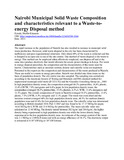| dc.description.abstract | The rapid increase in the population of Nairobi has also resulted in increase in municipal solid waste production. However, solid waste disposal in the city has been characterized by inefficiency and poor organizational structures. Only about 40% of the waste is collected and this is dumped in an open site in one of the city estates.
One method of waste disposal is the waste to energy. This method can be employed when effectively employed, can dispose off and at the same time produce electricity that would alleviate the severe power shortage in Kenya. For waste to energy disposal procedure, the composition and the characteristics of the waste must be known. Characteristics such as moisture content, density and calorific value are important. Presented in this report are the composition and characteristics of the waste produced in Nairobi. These are useful to a waste to energy procedure.
Nairobi was divided into three zones on the basis of population density. The city centre was also sampled. The sampling was carried out according to the American Society of Testing and Materials (ASTM) standard method for unprocessed municipal solid waste (D 5231-92) and the Cascadia Consulting Group inc., 2003. In high population density zones, the composition averaged 64.2% putrescibles, 14,4% plastic, 12.4% LWTR, 7.9% inorganics and 6.4% paper. In low population density zones, the composition averaged 56.5% putrescibles, 15.8% plastics, 4.2% L WTR, 11.4% inorganics and 12.3% paper. The overall composition of waste in Nairobi averaged 58.8% putrescibles, 13.8% plastic, 7.8% LWTR, 8.3% inorganic and 11.3% paper.
The waste was oven dried and the moisture content averaged 69% for high population density zone, 69.5% for medium density population zone and 63.6% for low population density zone.
The calorific value was determined according to British standard 1016: Part 5:1967 and was found to be 17.17 MJ/kg for paper, 16.63 MJ/kg for L WTR and 15.4 MJ/kg for putrescibles. The mean calorific value was calculated as 12.48 Ml/kg, The density varied between 282 kg/nr' and 296 kg/rn', the higher density being experienced in high population density one while the lower density being experienced in the low population density zone. An estimate of the energy content of the waste was 2.1 MJ/kg or 2100 KJI tonne and with an energy efficiency of 54.1%. The electricity output is estimated at 0.197 kWh/kg or 197 kWh/tonne. | en_US |

